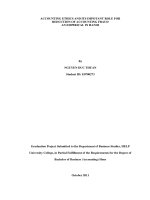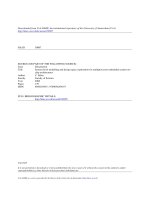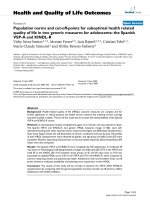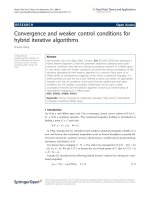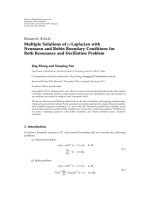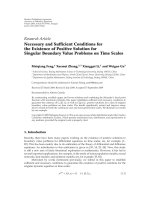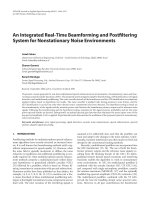Modeling time varying and multivariate environmental conditions for extreme load prediction on offshore structures in a reliability perspective
Bạn đang xem bản rút gọn của tài liệu. Xem và tải ngay bản đầy đủ của tài liệu tại đây (4.4 MB, 319 trang )
MODELING TIME VARYING AND MULTIVARIATE
ENVIRONMENTAL CONDITIONS FOR EXTREME LOAD
PREDICTION ON OFFSHORE STRUCTURES IN A
RELIABILITY PERSPECTIVE
ZHANG YI
NATIONAL UNIVERSITY OF SINGAPORE
2014
MODELING TIME VARYING AND MULTIVARIATE
ENVIRONMENTAL CONDITIONS FOR EXTREME LOAD
PREDICTION ON OFFSHORE STRUCTURES IN A
RELIABILITY PERSPECTIVE
ZHANG YI
(B. Eng. Nanyang Technological University)
A THESIS SUBMITTED
FOR THE DEGREE OF DOCTOR OF PHILOSOPHY
DEPARTMENT OF CIVIL AND ENVIRONMENTAL ENGINEERING
NATIONAL UNIVERSITY OF SINGAPORE
2014
To my mother
ACKNOWLEDGEMENT
I would like to express my sincere gratitude to my supervisors, Professor Quek
Ser Tong and Professor Michael Beer, for their excellent guidance and warm
encouragement throughout my Ph.D study. Their precious judgments and critical
comments in the revision of my writing have helped me to refine my research
tremendously. I am grateful to them for their contribution, not only the research
works, but also to teaching me how to become a better researcher.
I would like to thank Dr Zhang Mingqiang for his generously sharing with
me his knowledge on the uncertainty modeling and experience of Ph.D studies. I
could never adequately express all the helps and supports that he has given to me.
I like to share my joy of completing the thesis with my friends, especially
Dr Zhang Zhen, Miss Liu Mi, Miss Ge Yao, Mr Dai Jian, Dr Wang Yanbo, Dr
Wang Li, Dr Ye Feijian, Mr Lu Yitan and Mr Luo Min. I also want to extend my
sincere thanks to the other colleagues from the structural lab of National
University of Singapore. Their helpful discussion and persistent friendship has
made my Ph.D study quite enjoyable and fruitful.
My deepest gratitude goes to my family for their help, encouragement and
support through all these years. Most importantly, I owe my loving thanks to my
mother for her unlimited love and warm care. Without her continuous support and
encouragement, I never would have been able to achieve my goals.
ii
Finally, I wish to acknowledge the heartwarming support provided by my
dear wife, who has always been the person most understand me and give me the
unflagging love.
iii
TABLE OF CONTENTS
TITLE PAGE
DECLARATION PAGE
ACKNOWLEDGEMENT i
TABLE OF CONTENTS iii
SUMMARY vii
LIST OF TABLES x
LIST OF FIGURES xiii
LIST OF SYMBOLS xvii
Chapter 1 Introduction 1
1.1 Background 1
1.1.1 Robust Extreme Models 4
1.1.2 Time Varying Environment 5
1.1.3 Multivariate Environment 6
1.1.4 Efficient Methods for Multivariate Analysis 7
1.2 Objectives and Scope of Thesis 8
1.3 Limitations 9
1.4 Organization of Thesis 10
Chapter 2 Literature Review 14
2.1 Environment Modeling in Analysis of Offshore Structures 14
2.2 Framework of Reliability Analysis 19
2.2.1 Measures of Reliability 21
2.2.2 Simulation Methods 22
2.2.3 Transformation Techniques 26
2.3 Long Term Assessment Criteria 28
2.4 Extreme Value Theory 32
2.4.1 Asymptotic Model 33
iv
2.4.2 Inference for the Extreme Value Distribution 35
2.5 Concluding Remarks 39
Chapter 3
Establishing Robust Extreme Value Model 41
3.1 Introduction 42
3.2 Peak-Over-Threshold (POT) Method 44
3.2.1 Pareto Family 44
3.2.2 Poisson-GPD Model 45
3.2.3 Declustering 48
3.2.4 Parameter Estimate Method 53
3.3 Uncertainty Assessment of POT Method 57
3.3.1 Effects of Tail Behavior 59
3.3.2 Effects of Noise 64
3.3.3 Effects of Range of Dependency 70
3.4 Effects of Nonstationarity through Random Set Approach 76
3.4.1 Review of Random Set and Dempster-Shafer Structure 77
3.4.2 Selection of Threshold and Time Span 80
3.4.3 Uncertainty Quantification 85
3.5 Concluding Remarks 89
Chapter 4
Modeling the Time Varying Environmental Condition for
Offshore Structural Analysis
92
4.1 Introduction 93
4.2 Field Data at Ocean Site 96
4.2.1 Seasonal Characteristics 96
4.2.2 Directional Characteristics 98
4.3 Test for Stationarity of Poisson-GPD model 103
4.3.1 Segmentation Algorithm for Seasonality 104
4.3.2 Segmentation Algorithm for Directionality 113
4.4 Time Varying Modeling 118
4.4.1 2D Fourier Series Characterization 118
v
4.4.2 Model Validation 123
4.5 Static Push-Over Analysis 129
4.5.1 Structural Model Description 129
4.5.2 Reliability Analysis with Importance Sampling 132
4.6 Concluding Remarks 139
Chapter 5
Modeling the Multivariate Environmental Condition for the
Offshore Structural Analysis 142
5.1 Introduction 142
5.2 Bivariate Models for Sea State Parameters 145
5.2.1 Conditional Joint Distribution Model 145
5.2.2 Nataf Model 148
5.3 Copula Theory 150
5.3.1 Definition and Basic Properties 150
5.3.2 Examples of Copula 153
5.3.3 Dependence Concepts 158
5.4 Comparative Study in Multivariate Modeling 160
5.4.1 Data Pre-treatment 160
5.4.2 Application of Bivariate Models 167
5.4.3 Results and Discussions 175
5.5 Time Domain Structural Analysis 180
5.5.1 Proposed Discretized Copula Approach 182
5.5.2 Structural Analysis of a Fixed Offshore Platform 187
5.5.3 Results and Discussions 196
5.6 Concluding Remarks 200
Chapter 6 Conclusions 202
6.1 Summary of Thesis 202
6.2 Recommendation of Future Works 204
vi
REFERENCES 209
Appendix A. Detailed Information of Four Discretization Steps 223
Appendix B. Uncertainty Assessment in POT Method 239
Appendix C. Selection of Threshold and Time Span in POT Method 254
Appendix D. Testing Values of Threshold and Time Span in POT Approach for
Each Identified Time Sectors 259
Appendix E. USFOS Program Input for the Example Structure 264
Appendix F. Example of Constructing a Random Set Model 285
Appendix G. Information of Selected Wave Data and Basic Linear Wave Theory
288
vii
SUMMARY
With the changing environmental conditions experienced over the last decade,
design against failures of offshore structures has becomes even more challenging.
Complexities exist in various steps, from translating and modeling of the
environmental data, appropriate structural analysis, reliability assessment,
installation, operations and maintenance. This is compounded by the presence of
climatic influence which significantly affects the observed physical variables,
leading to uncertainties in characterizing the system. It is essential to quantify
and model the uncertainties associated with the real data collected and consider
them in the long term safety assessment of new and existing offshore structures.
This thesis focuses on the characterization of the time varying
characteristics of variables associated with the environmental loads, the
dependencies between these variables, and investigating the impact of the
uncertainties and dependencies on the long term assessment of a typical marine
structure. The wave parameters which directly influence the loadings on offshore
structures are studied in this work.
Considering the long time life-span and the limited data normally
available, extreme value (EV) statistical models have been commonly adopted to
describe environmental loads. Such class of models has assumptions that may not
be fulfilled for some variables, such as independence between data points and the
stationarity of the data. As such, compound extreme value statistical models have
also introduced, for example, the peak-over-threshold (POT) model. Using the
viii
same set of simulated data, both the EV and POT models are compared in this
study, where the latter is found to be a more inclusive and better approach. It is
also found that the accuracy associated with each model is sensitive to the
parameter estimate method used, especially if available data is limited. To
characterize the uncertainties associated with the parameters, namely, the
threshold u and time span ∆t, a random set model is proposed in the context of the
POT approach. Such elaborate measure in the form of imprecise probabilities
could reflect the intensities of uncertainty in the selection of parameters more
realistically.
By analyzing various segments of the collected data, stationarity of the
parameters can be established. If the non-stationary is slowly time varying, then a
simple means to account for this is through appropriate division of the data into
stationary segments. A modified segmentation algorithm with specified fixed
time interval is proposed to extract homogeneous data sets from non-stationary
time series data. To select the time interval, the data fitting is recursively
performed until the sample data can satisfactorily fit the Poisson-Generalized
Pareto Distribution (GPD) model. Two-dimensional Fast Fourier transform is
employed to characterize the variations of extreme values with time. A collected
group of data is selected to demonstrate that such a discretized model can provide
a more reasonable and accurate characterization of each parameter of interest.
This approach of incorporating the time varying effect is examined through the
reliability analysis of an existing offshore platform. The results show that
incorporating the co-variate effects in the statistical model can better reflect the
ix
underlying physical processes and help detect the most critical environmental
conditions for the structure within a marine environment.
In a multivariate environment, the dependencies between the load-related
environmental parameters can be a major concern. Extending beyond the linear
correlation coefficient, the concept of copula is introduced to improve the
quantification of the dependencies between variables as how the pairs of data are
spread is considered. A further refinement is proposed through a discretized
copula approach with a scheme to reduce the numerical efforts in deriving the
long term response distribution of the offshore structure. A numerical example is
presented to demonstrate that the proposed method produces more accurate results
as the most critical sea states are identified. The newly developed method can be
extended to a multivariate problem based on the copula model.
x
LIST OF TABLES
Table 2.1 Distribution models for selected ocean parameters. 16
Table 2.2 Target reliability levels in design codes. 30
Table 3.1 Bias of estimated 99
th
percentile for different tails n=20, 100. 63
Table 3.2 Bias of estimated 99
th
percentile for different noise condition n=20,
100 70
Table 4.1 Statistics of H
S
over four defined seasons 97
Table 4.2 Statistics of wave directions over four defined seasons 99
Table 4.3 Summary of tested algorithms in different segmentations of H
S
with
respect to time. 111
Table 4.4 Summary of tested statistics for different segmentations of extreme H
S
with respect to directionality. 117
Table 4.5 Estimated shape parameter ξ in each discretized sector. 117
Table 4.6 Estimated scale parameter σ in each discretized sector. 117
Table 4.7 Random variables in reliability analysis. 132
Table 4.8 Determined coefficients of Eq. (4.19) for different directions. 134
Table 4.9 Failure probability of jacket structure for different time and directional
sector of wave model. 136
Table 4.10 Determined coefficients of Eq. (4.19) for rotated structure. 138
Table 4.11 Failure probability of rotated jacket structure with respect to wave
model 139
Table 5.1 Conditional joint distribution models for selected stochastic ocean
parameters. 147
Table 5.2 Examples of Archimedean Copulas. 155
Table 5.3 Regression results for points representing H
S
within interval values of
0.5 168
Table 5.4 Regression results for points representing H
S
within interval values of
0.1 170
Table 5.5 Regression results for k vs H
S
and λ vs H
S
. 172
Table 5.6 Results of marginal distribution model parameter estimates. 174
Table 5.7 Comparison of parameter estimates and goodness-of-fit to the data for
the 3 approaches. 176
Table 5.8 Sea states and values of simulation parameters for the same accuracy.
196
xi
Table 5.9 Results of proposed approach in determining long term base shear for
P
E
=0.01. 199
Table A.1 Results of structural analysis in each subcopula. 237
Table B.1 Bias of estimated results (shape parameter ξ, scale parameter σ and
99
th
percentile) based on simulations from GPD model (u=1, ξ =-0.5,
σ=2). 240
Table B.2 Bias of estimated results (shape parameter ξ, scale parameter σ and
99
th
percentile) based on simulations from GPD model (u=1, ξ =-0.25,
σ=2). 241
Table B.3 Bias of estimated results (shape parameter ξ, scale parameter σ and
99
th
percentile) based on simulations from GPD model (u=1, ξ =0,
σ=2). 242
Table B.4 Bias of estimated results (shape parameter ξ, scale parameter σ and
99
th
percentile) based on simulations from GPD model (u=1, ξ =0.25,
σ=2). 243
Table B.5 Bias of estimated results (shape parameter ξ, scale parameter σ and
99
th
percentile) based on simulations from GPD model (u=1, ξ =0.5,
σ=2). 244
Table B.6 Bias of estimated results (shape parameter ξ, scale parameter σ and
99
th
percentile) based on simulations from GPD model (u=1+N(0,0.1),
ξ =-0.5, σ=2). 245
Table B.7 Bias of estimated results (shape parameter ξ, scale parameter σ and
99
th
percentile) based on simulations from GPD model (u=1+N(0,0.3),
ξ =-0.5, σ=2). 246
Table B.8 Bias of estimated results (shape parameter ξ, scale parameter σ and
99
th
percentile) based on simulations from GPD model (u=1+N(0,0.5),
ξ =-0.5, σ=2). 247
Table B.9 Bias of estimated results (shape parameter ξ, scale parameter σ and
99
th
percentile) based on simulations from GPD model (u=1, ξ =-0.5,
σ=2+N(0,0.2)). 248
Table B.10 Bias of estimated results (shape parameter ξ, scale parameter σ and
99
th
percentile) based on simulations from GPD model (u=1, ξ =-0.5,
σ=2+N(0,0.6)). 249
Table B.11 Bias of estimated results (shape parameter ξ, scale parameter σ and
99
th
percentile) based on simulations from GPD model (u=1, ξ =-0.5,
σ=2+N(0,1.0)). 250
xii
Table B.12 Bias of estimated results (shape parameter ξ, scale parameter σ and
99
th
percentile) based on simulations from GPD model (u=1, ξ =-
0.5+N(0,0.05), σ=2). 251
Table B.13 Bias of estimated results (shape parameter ξ, scale parameter σ and
99
th
percentile) based on simulations from GPD model (u=1, ξ =-
0.5+N(0,0.15), σ=2). 252
Table B.14 Bias of estimated results (shape parameter ξ, scale parameter σ and
99
th
percentile) based on simulations from GPD model (u=1, ξ =-
0.5+N(0,0.25), σ=2). 253
Table C.1 P-value of K-S test for exceedances following GPD with different
values of (u, ∆t). 254
Table C.2 P-value of K-S test for occurrences of exceedances following Poisson
process with different values of (u, ∆t). 255
Table C.3 Estimated lower bound of 0.95 confidence interval for 100 year design
value with different values of (u, ∆t). 256
Table C.4 Estimated upper bound of 0.95 confidence interval for 100 year design
value with different values of (u, ∆t). 257
Table C.5 Number of exceedances above the threshold after applying the POT
method with different values of (u, ∆t). 258
xiii
LIST OF FIGURES
Figure 1.1 Different types of offshore structures. 1
Figure 1.2 Controlled burning in Usumacinta jack-up after its first fire. 3
Figure 1.3 Organization of the thesis. 13
Figure 2.1 Failure domain of performance function G(.) in the variable space 21
Figure 2.2 Schematic showing of statistical response characterization in reliability
analysis. 25
Figure 2.3 Reliability analysis by using response surface method. 28
Figure 2.4 Illustration of different tail behavior in Type I (ξ =0, μ=0, σ=1), Type
II (ξ =0.5, μ=0, σ=1) and Type III (ξ =-0.5, μ=0, σ=1). 35
Figure 3.1 (a) Scatter plot of time series measurement (b) Clusters identification
(c) Identified extreme values after declustering. 50
Figure 3.2 Bias of estimated scale parameter for different tails. 62
Figure 3.3 Bias of estimated shape parameter for different tails. 63
Figure 3.4 Bias of estimated scale parameter ((a), (b) and (c)) and shape
parameter ((d), (e) and (f)) with the noise effect in location parameter
in GPD model. 67
Figure 3.5 Bias of estimated scale parameter ((a), (b) and (c)) and shape
parameter ((d), (e) and (f)) with the noise effect in scale parameter in
GPD model 68
Figure 3.6 Bias of estimated scale parameter ((a), (b) and (c)) and shape
parameter ((d), (e) and (f)) with the noise effect in shape parameter in
GPD model 69
Figure 3.7 Plots of autocorrelation functions for two tested time series (a) Case 1:
φ=0.95 (b) Case 2: φ=0. 71
Figure 3.8 Biases of estimated 99
th
percentile in AMM and r largest order statistic
method for two time series. (a) Case 1: φ=0.95 (b) Case 2: φ=0. 73
Figure 3.9 Biases of estimated 99
th
percentile in POT method for two time series
(a) Case 1: φ=0.95 (b) Case 2: φ=0. 74
Figure 3.10 Imprecise probability. 80
Figure 3.11 Mean residual plot with 95% confidence intervals 82
Figure 3.12 L-moment plot for exceedances over selected threshold with
theoretical GPD curve 83
Figure 3.13 Autocorrelation plot for the wave time series records 84
Figure 3.14 Appropriate region for u and ∆t. 85
xiv
Figure 3.15 Constructed imprecise probability model for 100-year return value
with mean value of all estimates. 87
Figure 3.16 Constructed imprecise probability model for 100-year return value
based on different sample set: (a) Jan (b) Jan-Mar (c) Jan-Jun. Dotted
line represents mean of all estimates. 89
Figure 4.1 Time varying effects on safety of structures. 94
Figure 4.2 Box plot of H
S
for four different defined seasons. 97
Figure 4.3 Histograms of H
S
in four different defined seasons. 98
Figure 4.4 Angular histograms of H
S
over four different defined seasons (red line
represents the resultant vector length). 100
Figure 4.5 2D kernel density plot of H
S
with directionality and seasonality. 101
Figure 4.6 Isoline plot of H
S
with directionality and seasonality. 102
Figure 4.7 Results of t-statistic for discretized time series. 108
Figure 4.8 2D kernel density plot of extreme H
S
with directionality and time. . 112
Figure 4.9 Comparison of C
i
values between different segmentations for time
sector [0.10, 0.35) 116
Figure 4.10 Discrete spectrum for shape and scale parameters after DFT. 121
Figure 4.11 2D Fourier characterizations of shape and scale parameter changes
along the time and direction axes. 121
Figure 4.12 CDF of original data and simulated data for θ (-10
o
~62
o
]. 124
Figure 4.13 CDF of original data and simulated data for θ (62
o
~134
o
]. 125
Figure 4.14 CDF of original data and simulated data for θ (134
o
~206
o
]. 125
Figure 4.15 CDF of original data and simulated data for θ (206
o
~278
o
]. 126
Figure 4.16 CDF of original data and simulated data for θ (278
o
~350
o
]. 126
Figure 4.17 Comparison of simulated and original mean of H
S
with time. 128
Figure 4.18 Comparison of simulated and original observed wave directions 128
Figure 4.19 Jacket structure framing. 129
Figure 4.20 Plasticity utilization plot. 131
Figure 4.21 Comparison between calculated base shear and curve fit. 135
Figure 5.1 Sketch of several conditional probability density curves of T
P
at
various values of H
S
. 146
Figure 5.2 Comparison of different bivariate copulas for marginal distributions
following standard normal distributions for correlation coefficient
equals to 0.8. 156
Figure 5.3 Box plot of H
S
and V
W
over different months. 161
Figure 5.4 Comparison of dependencies between H
S
and T
P
for two different
months. 164
xv
Figure 5.5 Comparison of dependence between θ
S
and θ
W
over two different
months. 165
Figure 5.6 Rose plot of wave direction in Nov-Feb. 166
Figure 5.7 Histogram of difference between wind direction and wave direction
(θ
S
- θ
W
). 166
Figure 5.8 Nonlinear fit of (a) μ[ln(T
P
)] vs H
S
and (b) σ
2
[ln(T
P
)] vs H
S
based on
Eq. (5.1) and Eq. (5.3) for points representing H
S
within interval
values of 0.5. 168
Figure 5.9 Nonlinear fit of (a) μ[ln(T
P
)] vs H
S
and (b) σ
2
[ln(T
P
)] vs H
S
based on
Eq. (5.1) and Eq. (5.3) for points representing H
S
within interval
values of 0.1. 170
Figure 5.10 Nonlinear fit of (a) k vs H
S
and (b) λ vs H
S
based on Eqs. (5.23) &
(5.24). 171
Figure 5.11 Marginal parametric model fit for (a) H
S
, (b) T
P
, and (c) V
W
. 173
Figure 5.12 Tail fittings of marginal parametric model for (a) H
S
, (b) T
P
, and (c)
V
W
. 174
Figure 5.13 Comparison of contour plot between original data and (a) copula
approach, (b) Nataf model, (c) conditional joint model for H
S
and T
P
.
178
Figure 5.14 Comparison of contour plot between the original data and (a) copula
approach (b) Nataf model (c) conditional joint model for H
S
and V
W
.
179
Figure 5.15 Schematic showing of proposed discretization procedure. 187
Figure 5.16 Illustration of JONSWAP spectrum for different sea states. 189
Figure 5.17 Illustration of JONSWAP spectrum for different peak shape
parameters. 190
Figure 5.18 Cut off frequency ω
cut
for different peak shape parameters. 192
Figure 5.19 Determination of number of frequencies N for a given peak period.
193
Figure 5.20 Determination of time interval ∆t for a given peak period. 193
Figure 5.21 Typical simulated wave elevations. 195
Figure 5.22 Schematic showing of discretization steps (u=F
1
(H
S
), v=F
2
(T
P
)) and
evaluation points. 197
Figure 6.1 Schematic showing of discretization procedures for three-dimensional
copula model. 206
Figure A.1 Numbering of subcopulas in first discretization. 233
Figure A.2 Numbering of subcopulas in second discretization. 234
xvi
Figure A.3 Numbering of subcopulas in third discretization 234
Figure A.4 Numbering of subcopulas in fourth discretization. 235
Figure A.5 Comparison of structural base shear for different sea states. 238
Figure C.1 Appropriate region for u and ∆t for significance level equals to 0.01.
255
Figure C.2 Influence of u and ∆t to (a) scale parameter, (b) shape parameter and (c)
100 year return value. 257
Figure D.1 Test of Poisson process in each identified time sector. 260
Figure D.2 Test of threshold by mean residual plot with 95% confident intervals
for all four time sectors. 261
Figure D.3 L-moment plot for exceedances over the selected threshold with the
theoretical GPD curve for all four time sectors. 262
Figure F.1 Random set (a) and its assigned probability weight (b). 286
Figure F.2 Probability box (a) and contour function (b). 287
Figure G.1 WIS data domain 288
Figure G.2 Geological location of the selected buoy 289
Figure G.3 Regular wave propagation properties 290
xvii
LIST OF SYMBOLS
Anderson-Darling statistic
AIC Akaike Information Criteria
Bel(x) belief function of x
C(.) copula function
C’ subcopula
C
Archimedean
(.) Archimedean copula
CDF cumulative distribution function
C
Gaussian
(.) Gaussian copula
C
θ
(.) one-parameter copula
d differentiation
DFT discrete Fourier transformation
D
i
cumulative sum statistic for Poisson process
DI dispersion index
D
n
Kolmogoriv-Smirnov statistic
E(.) expectation function
Exp(.) exponential distribution function
upper bound of cumulative probability function
lower bound of cumulative probability function
CDF of annual maximum of 10-minute mean wind
speed
CDF of maximum wave height in a stationary sea
state
conditional CDF of 1-hour mean wind speed for a
given value of H
S
conditional CDF of current speed for a given value
of H
S
F
F
10,max
,1Uyear
F
H
F
|
ws
VH
F
|
Cs
VH
F
xviii
conditional CDF of maximum wave height in a
stationary sea state
conditional CDF of wave height in a stationary sea
state
CDF of 10-minute mean wind speed
CDF of current velocity
CDF of short term distribution of wave height
F
y
steel yield strength
F
ξ
, F
σ
values of discrete spectrum for shape and scale
parameters
cumulative distribution functions for sector S
i
|
conditional PDF of T
p
for a given value of H
S
GEV generalized extreme value distribution
GPD generalized Pareto distribution
G
r
(.) r largest order statistics distribution function
H
100max
maximum wave height in 100 years
H
max
maximum wave height
H
S
significant wave height
I
x
(a, b) incomplete beta function
…;Θ
likelihood function
log
…;Θ
log-likelihood function
lim limit
Log natural logarithm
max maximum
min minimum
M
n
block maximum with size of n
rth largest value in a sequence of random variables
max
|
s
HH
F
|
s
HH
F
10
U
F
C
F
S
F
xix
N number of simulated wave frequency
PDF probability density function
P
E
exceedance probability
P
f
failure probability
Pls(x) plausibility function of x
Poi(.) Poisson distribution
POT peak over threshold method
Q(.|θ) short term distribution function for X(.)
R structure system’s resistance
R
ultimate
ultimate strength of jacket structure
S applied load
S
J
JONSWAP spectrum
S
PM
Pierson-Moskowitz (P-M) spectrum
T length of wave simulation
T steel tube thickness
t
i
seasonality value for observed wave height
T
p
wave peak period
T
z
zero crossing wave period
u threshold in POT
U vector of standard normal variables
u(.) horizontal water particle velocity
. horizontal water particle acceleration
Var(x) variance of variable x
V
w
wind speed
X(,) short term response conditioned on the ocean state
parameters θ
z
p
long term value with return level 1/p
xx
β reliability index
γ non-dimensional peak shape parameter
ε random noise
η(.) ocean surface elevation
θ
i
directionality value for observed wave height
θ
S
direction of waves
θ
w
direction of wind
μ location parameter
μ
x
mean of variable x
ξ shape parameter
ρ linear correlation coefficient
ρ
s
Spearman’s coefficient for measuring the
dependency
ρ
θ
angular linear correlation coefficient
σ scale parameter
σ
x
standard deviation of variable x
τ
k
Kendall’s coefficient for measuring the dependency
(.) probability density function for standard normal
variables
ω
cut
cut-off wave spectrum frequency
ω
k
, ω
l
discrete frequencies in DFT
element of
empty set
intensity function
intersection
L-moment ratio
modified scale parameter
.
43
/
xxi
real numbers
subset of
union
cumulative distribution function for standard
normal variables
(…,…) open interval
(, m) focal set
[…,…] closed interval
∂ partial differentiation
∆C discretized subcopula
∆P
E
subcopula exceedance probability
∆t time span
∆t
time_step
time step in time domain analysis
∆T time interval in the time segmentation algorithm
∏ product
∑ sum
∫ integration
→ mapping
∞ infinity
.
